Text
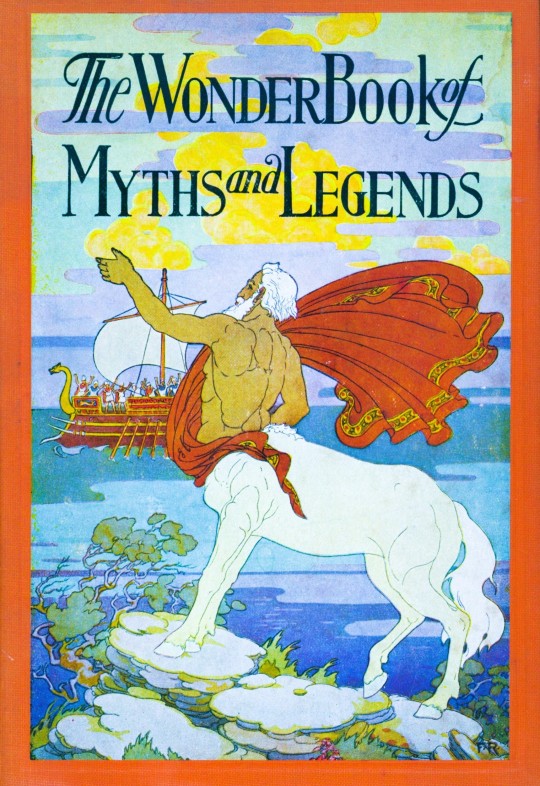









Mythical Wonders
This 1928 edition of The Wonder Book of Myths and Legends was compiled by editor and writer William Byron Forbush (1868-1927). It was published in Philadelphia by the John C. Winston Company, where Forbush served as a consulting editor. The edition is adorned with illustrations by Frederick Richardson (1862-1937), an American illustrator most well-known for his vivid and imaginative illustrations in the works of L. Frank Baum.
The book is a treasure trove of enchanting stories of magic and wonder that captivated the ancient world. It explores myths and legends from various cultures, interweaving tales of gods, heroes, and fantastical creatures. The illustrations are a testament to the Art Nouveau movement. His use of striking colors and creative depictions brings the stories to life in a way that genuinely charms the reader.
-Melissa, Special Collections Classics Intern
View other Classics posts.
View our other posts on children's books.
#classics#the wonder book of myths and legends#william byron forbush#john C. winston company#frederick richardson#art nouveau#myths#legends#illustrations#childrens books#ancient gods#Historical Curriculum Collection
0 notes
Text
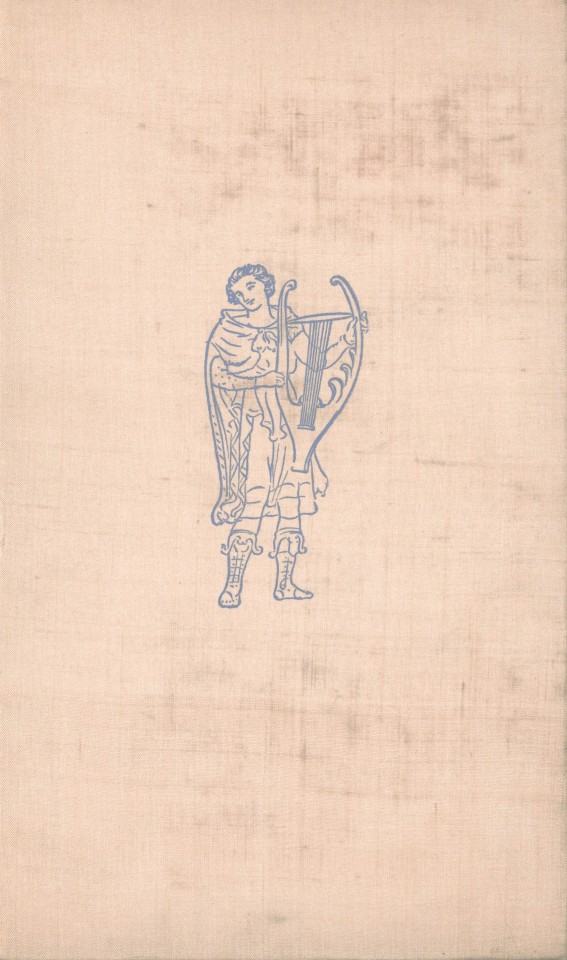
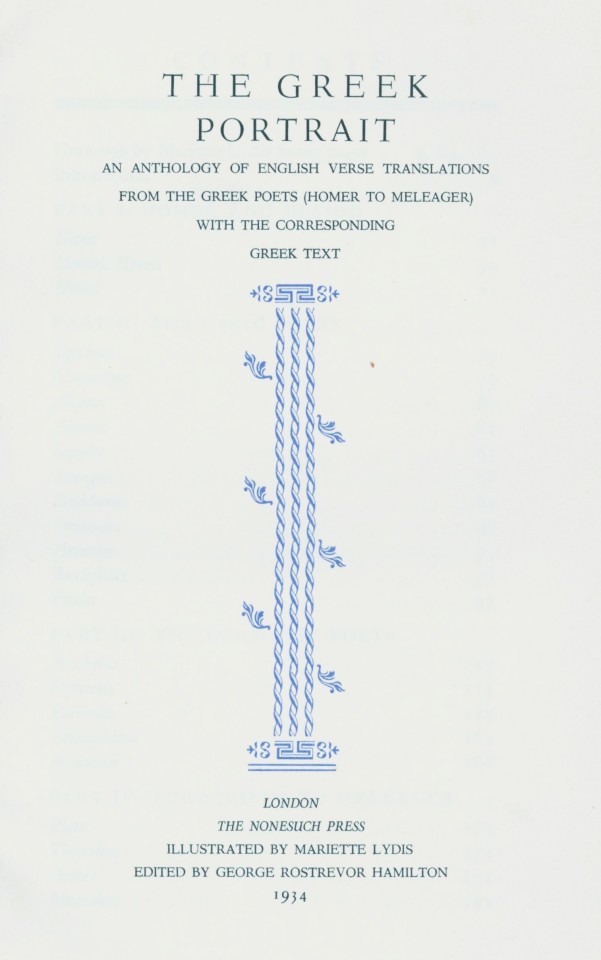

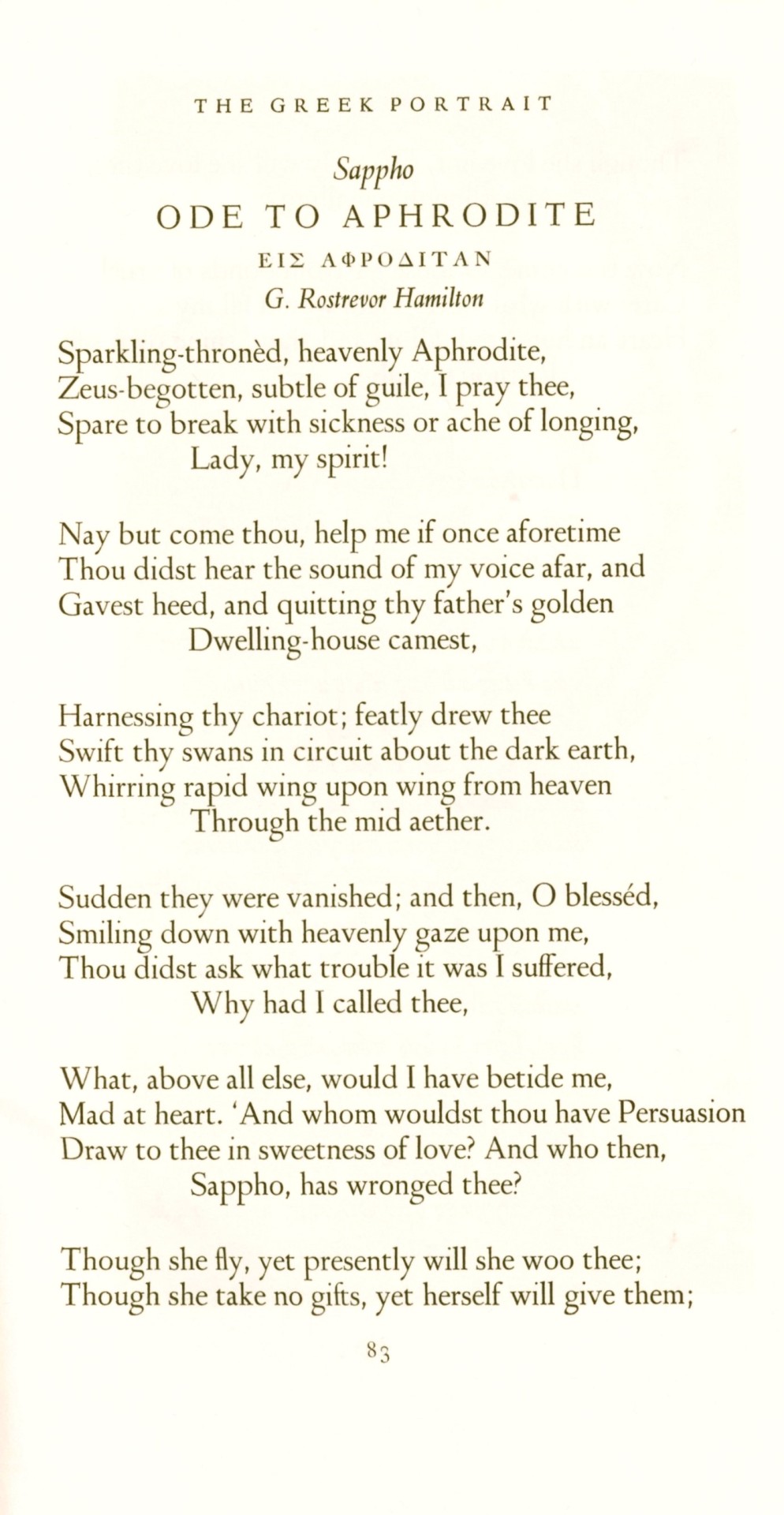
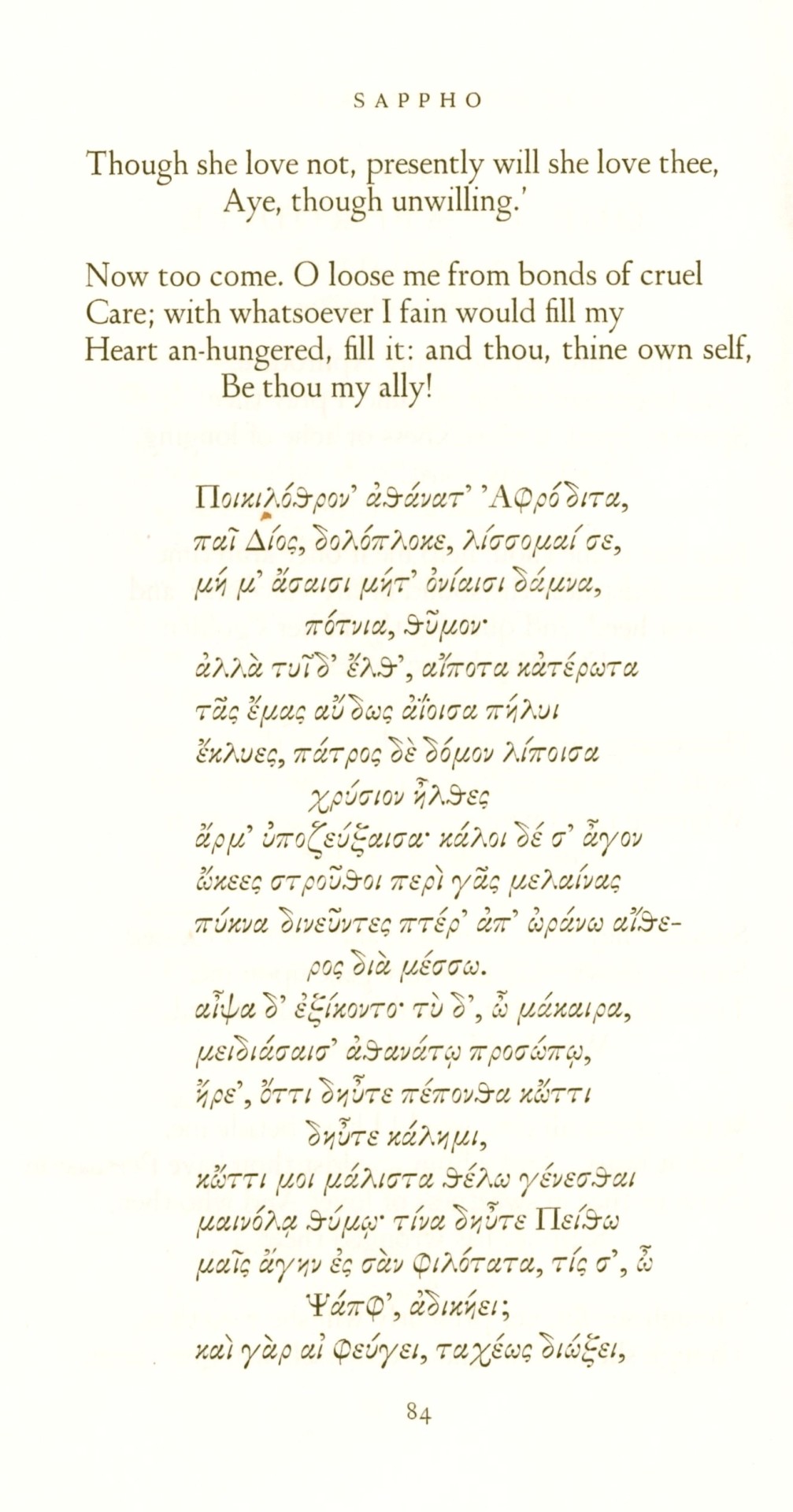
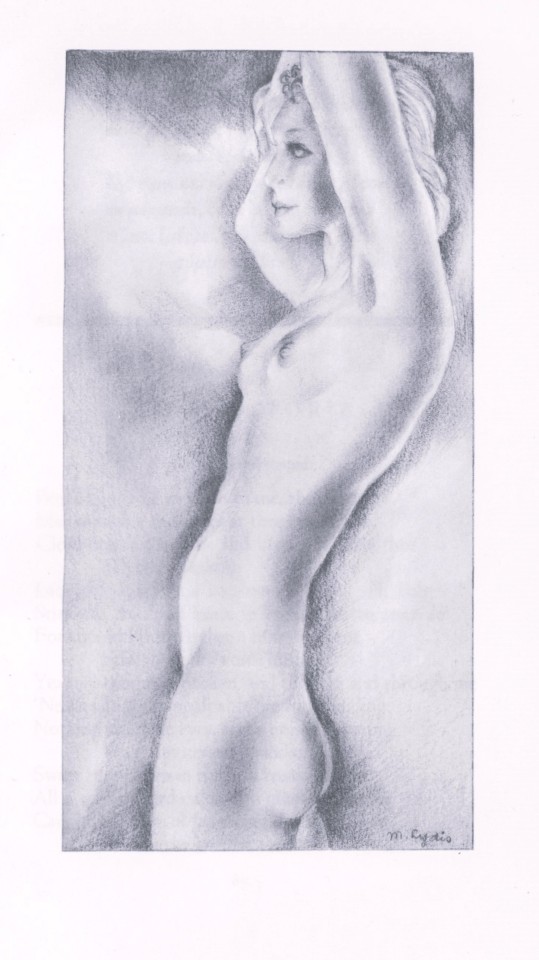

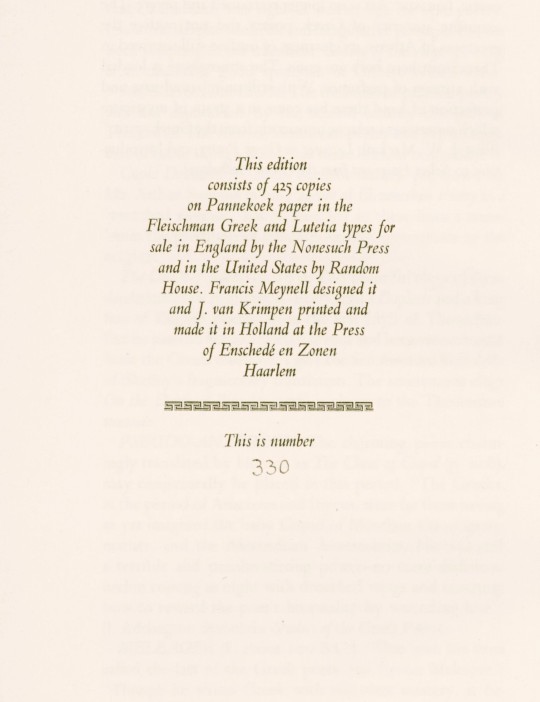

It's Fine Press Friday!
A Classic Representation
The Greek Portrait is an anthology of English verse translations of eminent Greek poets, from Homer to Meleager, with the corresponding Greek text presented alongside. Numerous translators provided the translations, taking on the arduous task of translating essential works from the Classical Period, including epic, lyric, and dramatic poetry.
This 1934 edition was designed by British fine-press publisher Francis Meynell (1891-1975) and printed in an edition of 425 copies by Dutch book and type designer Jan van Krimpen (1892-1958) at the Press of Enschedé en Zonen in Haarlem for Meynell's Nonesuch Press in London. The text was edited by English poet and critic George Rostrevor Hamilton (1888-1967) and printed on Pannekoek paper in Fleischman Greek and van Krimpen's Lutetia types.
The illustrations are by Mariette Lydis (1887-1970), an Austrian-Argentine painter known for her portraits, illustrations, and erotic engravings. She was a self-taught artist who began her career at a young age and had a history of creating what was considered controversial artwork during her lifetime. She gained recognition for creating lithographic depictions that celebrated lesbian and bisexual relationships. However, some critics of her work described the illustrations as "perverse.” We find these prints to be quite lovely, however.
-Melissa, Special Collections Classics Intern
View another post with illustrations by Mariette Lydis.
View our other posts with books from the Nonsuch Press.
View other Classics posts.
#classics#Nonesuch Press#The Greek Portrait#ancient greek#greek#greek poetry#Greek poets#Mariette Lydis#Francis Meynell#Jan van Krimpen#Joh. Enschedé en Zonen#Enschedé#George Rostrevor Hamilton#illustrations#english translations#epic poetry#lyric poetry#Fleischman Greek type#Lutetia type#Pannekoek paper#classical period#classical literature#anthologies#fine press books#fine press publishing#so dramatic
18 notes
·
View notes
Text




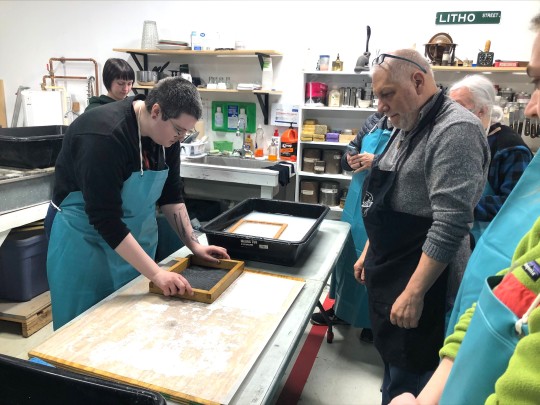

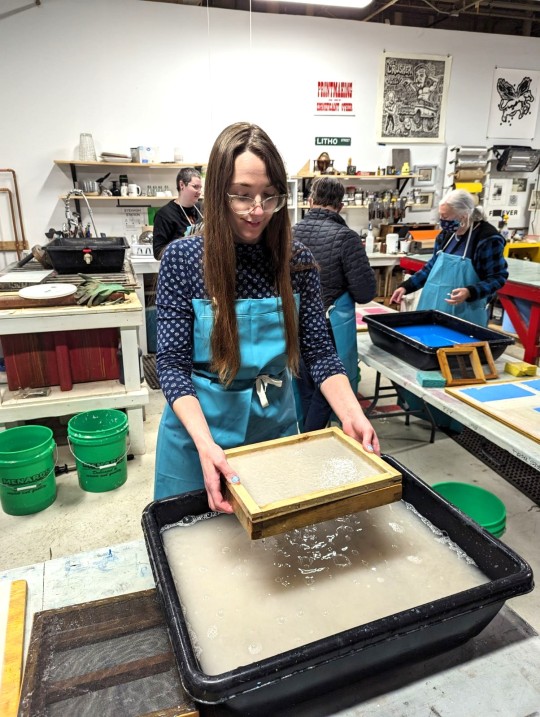


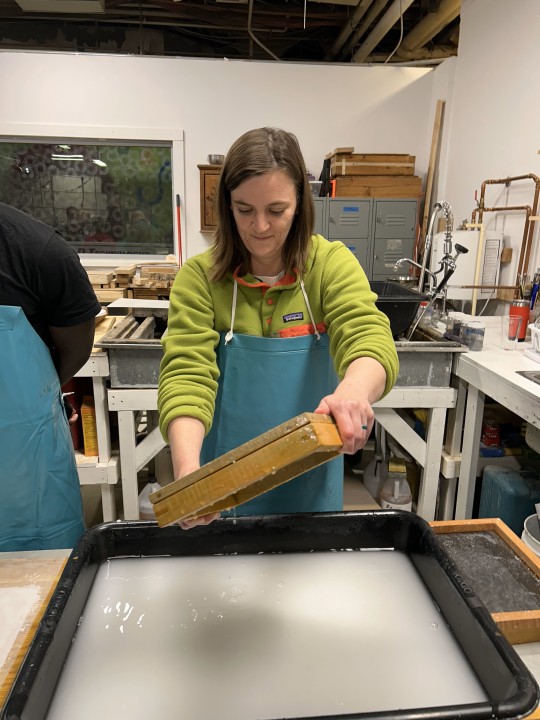


Papermaking at AP3!
A couple weeks ago and even this past Tuesday, we showed you how, after students in my History of Books & Printing class (INFOST 603) read about the invention of type and letterpress in Europe, we went down to Team Nerd Letterpress, set wood type, and printed a poster. Last week, after reading about the history and technique of hand papermaking, we took a field trip to Anchor Press, Paper, and Print (AP3) in the Riverwest section of Milwaukee to engage in some papermaking.
First, AP3 president Marilyn Propp demonstrated hogging the vat, using the deckle, dipping the screen, pulling a form, and couching the paper onto felts (here's a glossary) -- top three images. Then Miria tried their hands at the process, with much success (next three images). Afterwards, it was a free-for-all, with everyone making paper for the next hour and a half; here in succession are Anna, Caring, Adam, Georgia, and Catherine (with Taj in the background).
The last image is of some still-wet paper forms on felts (actually, synthetic pellons), with attempts at inclusions and paper lamination. The students were clearly exhilarated, and everyone went home exhausted and happy!
View more posts on papermaking.
-- MAX, Head of Special Collections
#Papermaking#hand papermaking#handmade paper#paper#instructions sessions#students#graduate students#Information Studies#INFOST 603#letterpress printing#Marilyn Propp#Anchor Press Paper and Print#AP3#student work
30 notes
·
View notes
Text

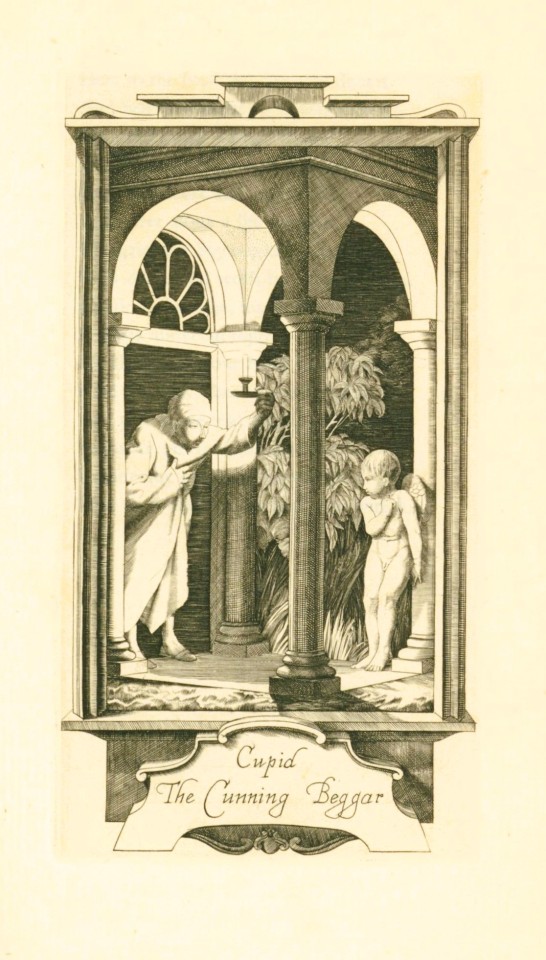





In Imitation of Anacreon
The Anacreontea, a collection of approximately fifty Greek poems attributed to the ancient Greek lyric poet Anacreon (c. 575-c. 495 BCE), dates from the 1st century BCE of the 6th century CE and holds a significant place in Greek literature. Although attributed to Anacreon, the work is believed to be authored by several anonymous imitators. These verses delve into themes of beauty, wine, romantic passion, and the veneration of the Greek god Dionysus.
Our 1923 edition of the Anacreontea, derived from the 1683 version translated from the Greek by English poet and essayist Abraham Cowley (1618-1667), includes a biography of Anacreon and a facsimile title page from the 1683 edition. The 1923 edition is limited to 725 copies and was printed at Nonesuch Press in Soho, London, with additional copperplate engravings by English artist Stephen Gooden (1892-1955).
Anacreon was a famous Greek lyric poet recognized for his lively drinking songs and erotic poems. Legend has it that, after his demise, the Athenians erected a statue of his intoxicated form in the Acropolis. It's safe to say that he was probably a popular guest at social gatherings! Abraham Cowley's translation of the Anacreontea opened the door for readers to explore this significant collection, bridging the gap between ancient Greek literature and contemporary English-speaking audiences.
The poems seem to have been created over a considerable period of time, from the era of Alexander the Great to sometime after the collapse of the Western Roman Empire. They depict the same whimsical refinement characteristic of most of Anacreon's authentic works, although they were not composed in the same Ionic Greek dialect that Anacreon typically employed. Despite not being penned by Anacreon himself, the poems have consistently captivated readers with their lyrical quality, creating a timeless connection between the past and present.
-Melissa, Special Collections Classics Intern
View other Classics posts
#Classics#classical literature#anacreon#Anacreontea#Greece#ancient greece#ancient greek#greek poetry#poetry#Abraham Cowley#translated literature#Nonesuch Press#Stephen Gooden#engravings#literary imitators#beauty#wine#romantic#passion#drinking songs#erotic poetry
26 notes
·
View notes
Text
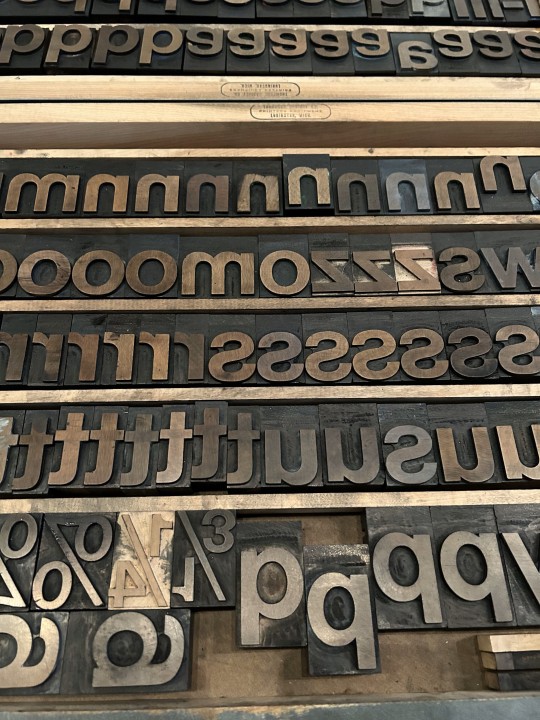
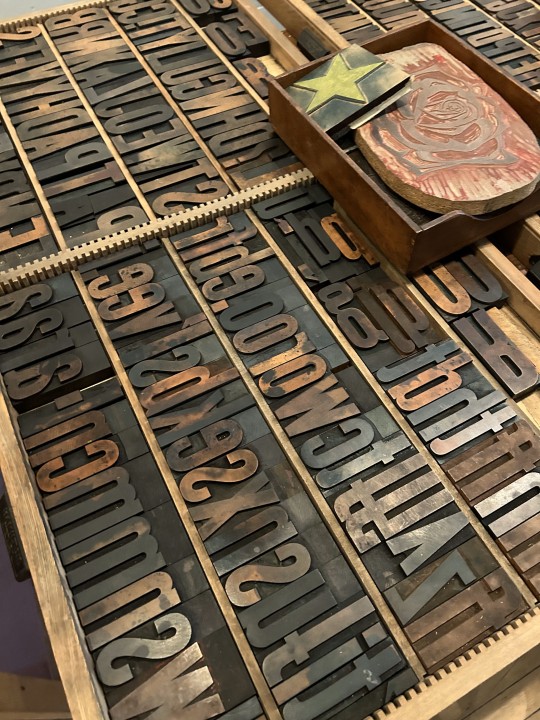


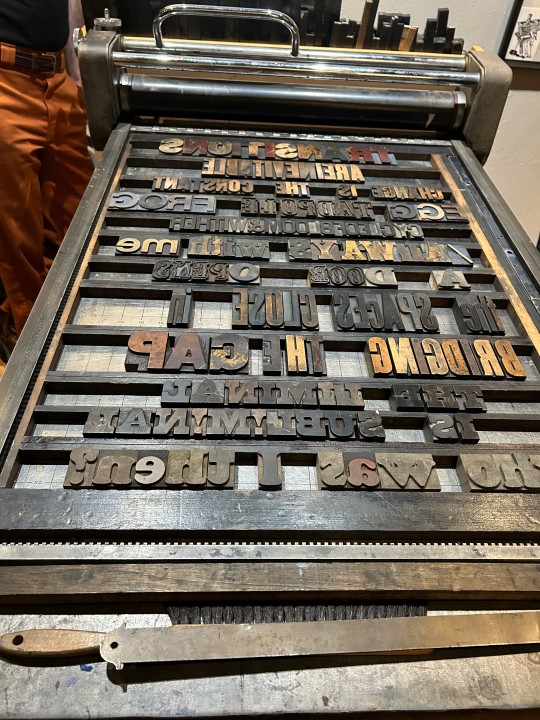




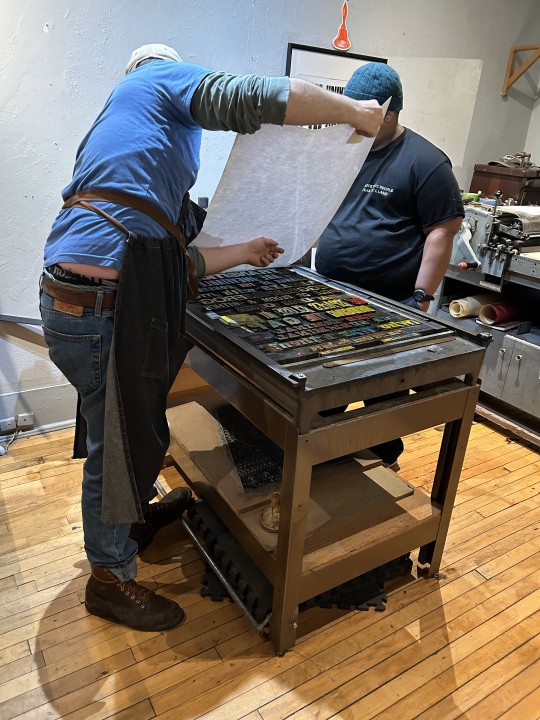
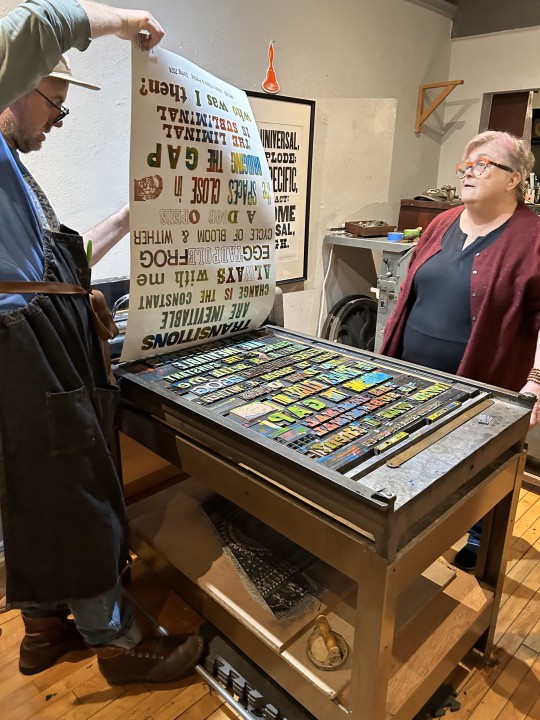

Typography Tuesday
MORE PRINTING WITH WOOD TYPE
One of my students sent me more images today from our letterpress venture at Team Nerd Letterpress for my History of Books & Printing course a couple of weeks ago. You can read more about the excursion in a post we did last week.
Shown here again are the type cases we worked from; setting and locking up the lines of type on the press bed; inking the type in blue and pulling a proof; then inking the type with a crazy kaleidoscope of colors and pulling multiple prints in rainbow colors.
That image of a sideways face after the line "the spaces close in" is a linocut portrait that Team Nerd proprietor Adam Beadel did of me years ago -- when I still had hair.

View more posts with wood type.
View our other Typography Tuesday posts.
– MAX, Head, Special Collections
#Typography Tuesday#typetuesday#instructions sessions#students#graduate students#Information Studies#INFOST 603#History of Books & Printing#letterpress#letterpress printing#wood type#Adam Beadel#Team Nerd Letterpress#type setting#broadsides#student work#exquisite corpse
59 notes
·
View notes
Text
GOOSE WATCH 2024
It's been a busy day in the goosey world of our green roof! This morning, mama goose (aka Mildred) was off the nest hanging out with papa goose (aka Horace) near the solar panels. I assume she was getting a little snack and gathering energy to keep sitting on those eggs!

Later, in the early afternoon, SPL Graduate Intern Jenna got this video of Mildred checking on her eggs and then settling back down on her nest to keep them warm. There are at least seven eggs, which is one more than we initially thought! If I'm correct, we're on week four of egg incubation so we're expecting baby geese pretty soon! We can't wait to see those little goslings toddling around the roof! Exclamation point!
Stay tuned for more breaking goose news and read our first post about this year's geese here.
-- Alice, Special Collections Department Manager
#Canada Geese#Geese#goose nest#goose news#Special Collections geese#Green Roof#goose watch 2024#Horace & Mildred#sedum#goose#Canada Goose
80 notes
·
View notes
Text
Milestone Monday - Earth Day Edition

Happy Earth Day!
Celebrated annually on April 22nd, Earth Day is an opportunity to support environmental protection and sustainability. The idea of Earth Day was first proposed by peace activist John McConnell (1915-2012) in 1969, but it didn’t fully take shape until Wisconsin senator (and former Wisconsin governor) Gaylord Nelson (1916-2005) initiated a nationwide environmental teach-in on April 22, 1970. Today, earthday.org carries the torch promoting international events, sharing educational tools and initiatives.
In observance of the day, we’re sharing an offset print entitled Earth published by Bread & Puppet Theater in 2000. This broadside was printed from masonite cuts created by Bread & Puppet Theater founder Peter Schumann (b.1934). Primarily known for their puppet shows, Bread & Puppet also operates a press that helps support the nonprofit through the sale of posters and publications, many of which can be found within our holdings!
View posts from Earth Days past.
Read other Milestone Monday posts here!
– Jenna, Special Collections Graduate Intern
#earth day#milestone monday#john mcconnell#gaylord nelson#bread & puppet theater#peter schumann#wood cut#offset print
23 notes
·
View notes
Text
Shakespeare Weekend
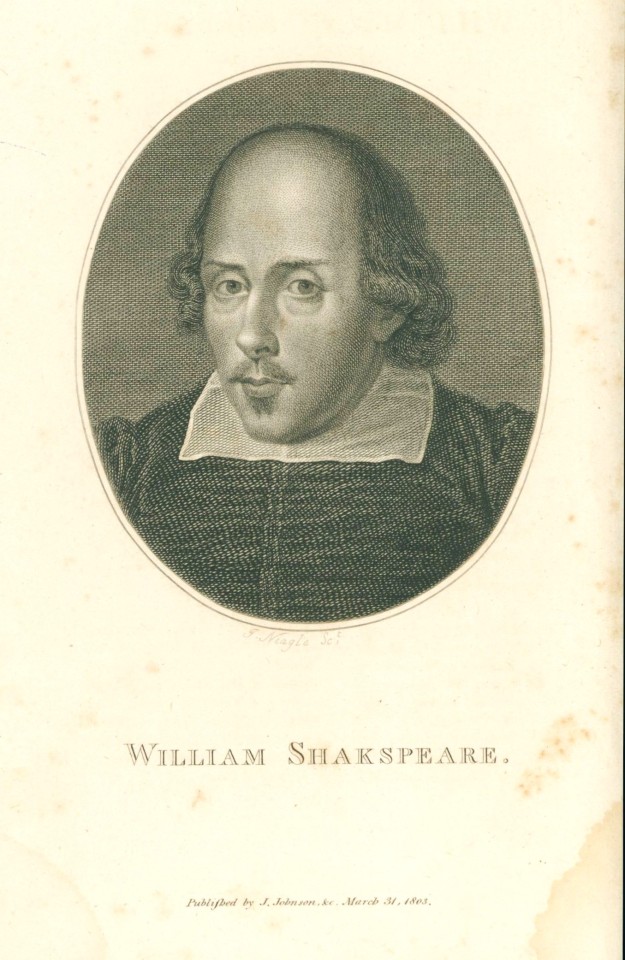



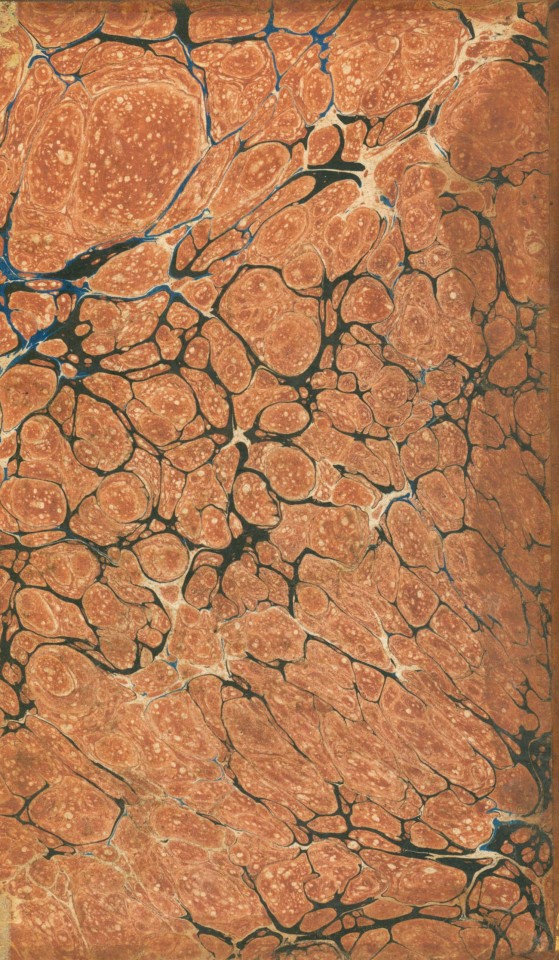
In 1803 Joseph Johnson (1738-1809) published the fifth edition of The Plays of William Shakespeare, in twenty-one volumes, with the corrections and illustrations of various commentators to which are added notes. Originally written by Samuel Johnson (1709-1784) and George Steevens (1736-1800), this fifth edition was edited by Isaac Reed (1742-1807) and became known as the first variorum edition of Shakespeare.
Reed’s collation of previous variations of Shakespeare proved to be a massive undertaking (twenty-one volumes!) that would be reprinted in 1813 and inspire future variorums like that of James Boswell the Younger in 1821 and the New Variorum Shakespeare Project that began in the 1870s and continues to this day as an official project of the Modern Language Association of America (which, btw, was headquartered here at the UWM libraries for 20 years, and the reason we have such a strong Shakespeare collection). The edition opens with a frontispiece engraving of Shakespeare by British engraver James Neagle (d. 1822) followed by an advertisement by Reed. Reed takes this opportunity to sing Steevens praises, including a eulogy written by William Hayley that reads in part “This tomb may perish, but not so his name who shed new lustre upon Shakespeare’s fame!”
Volume One continues with various prefaces and essays by the usual Shakespearean scholars and critics of the time, Malone, Pope, Warburton and of course Nicholas Rowe’s Life of Shakespeare. Printed by John Plymsell out of London, our edition features marble endpapers in a Stormont pattern.
View more Shakespeare Weekend posts.
-Jenna, Special Collections Graduate Intern
#joseph johnson#samuel johnson#george steevens#isaac reed#variorum#shakespeare#william shakespeare#shakespeare weekend#james neagle#engraving#edmond malone#alexander pope#william warburton#nicholas rowe#the plays of william shakespeare
21 notes
·
View notes
Text




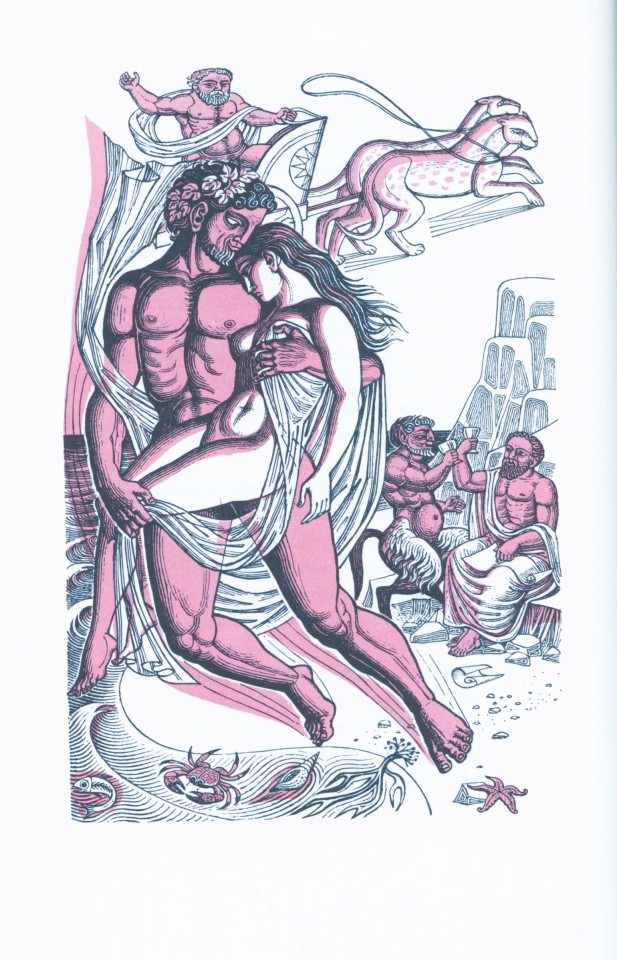

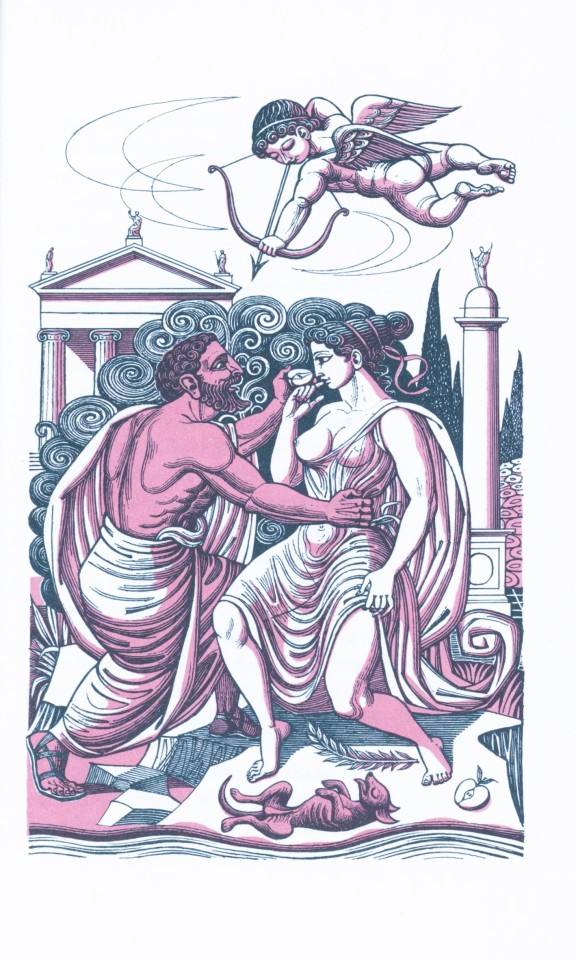


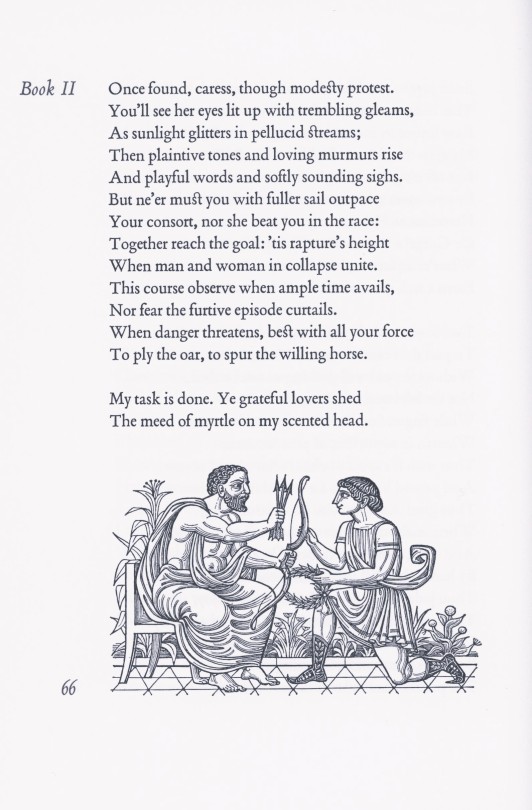

Classic Lessons in Love
Publius Ovidius Naso (43 BC-AD 17/18), more familiarly known as Ovid, was a Roman poet most famously known for his mythological history of the world, Metamorphoses. His satirical and sometimes dark take on all the intricacies of love and relationships is exhibited in Ars Amatoria. The Art of Love is a 1971 English translation edition of Ars Amatoria, translated by English classicist and scholar of Latin poetry B. P. Moore (1877-1955), with pen and ink illustrations by British artist Eric Fraser (1902-1983). The edition was designed by Robert L. Dothard and printed at the Press of A. Colish in Mount Vernon, NY, for members of the Limited Editions Club in an edition of 1500 copies on specially-made, oyster-white, mould-made paper crafted at the Arches mill in France.
In the first book of Ars Amatoria, Ovid guides men on how to successfully find a woman. In the second book, we see Ovid's advice shift towards maintaining a healthy relationship with one's partner. The third and final book, produced two years after the first two, focuses on advice for women on how to win and keep the love of a man. The work, however, was considered salacious and was banned by Emperor Augustus, with the charge of it being immoral, and is one of the few examples of the Roman government censoring a Roman author’s writing.
The topic's typical scenarios are presented engagingly, incorporating elements from Greek mythology, daily life in ancient Rome, and universal human experiences. Ovid offers hilarious advice, such as how women can keep their lovers from becoming neglectful by making them artificially jealous. He also advises men to never argue with their mistresses, as it could lead to expensive gift-giving in order to reconcile. When it comes to the sexes, it seems some things never change!
-Melissa, Special Collections Classics Intern
View other Classics posts.
View more posts from the Limited Editions Club.
#classics#ovid#love#lovers#Ars Amatoria#art of love#poetry#classical literature#roman poetry#greek mythology#ancient rome#relationships#advice#poet#Limited Editions Club#Press of A. Colish#Eric Fraser#B. P. Moore#Robert L. Dothard#fine press books
63 notes
·
View notes
Text


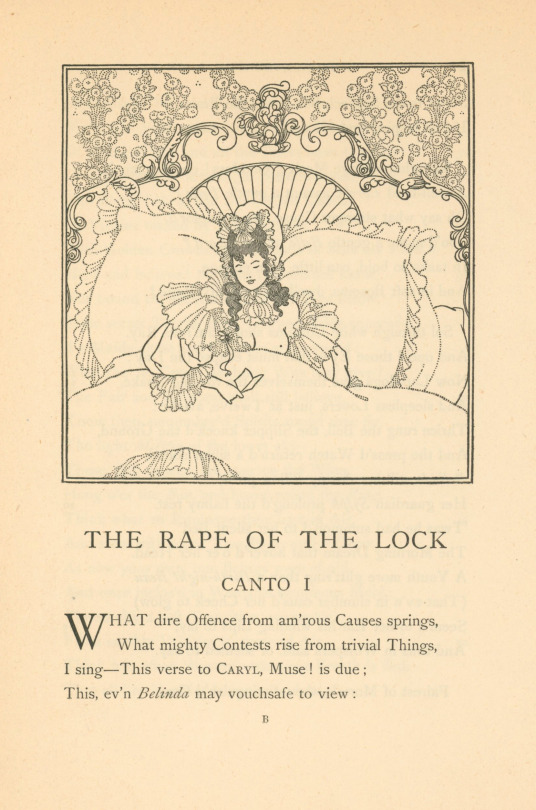
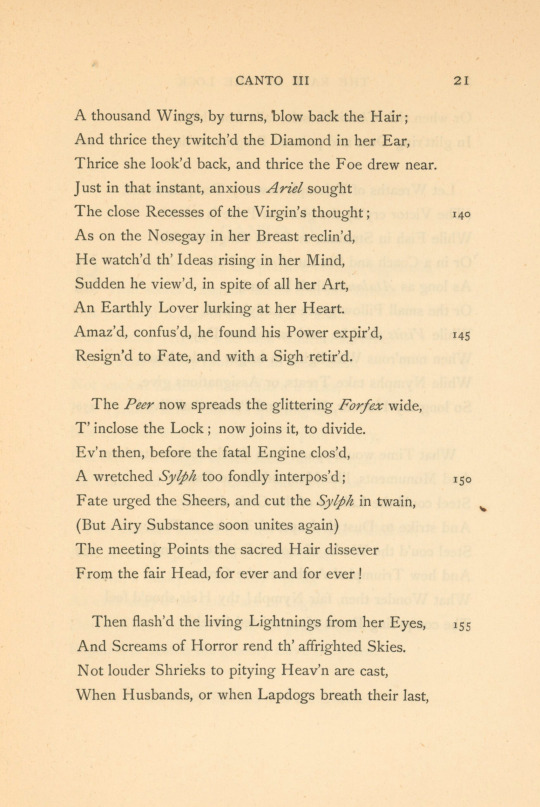


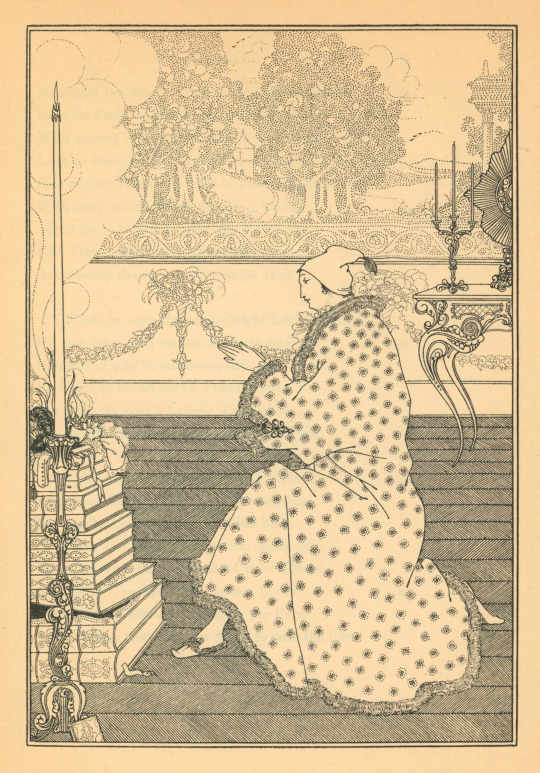

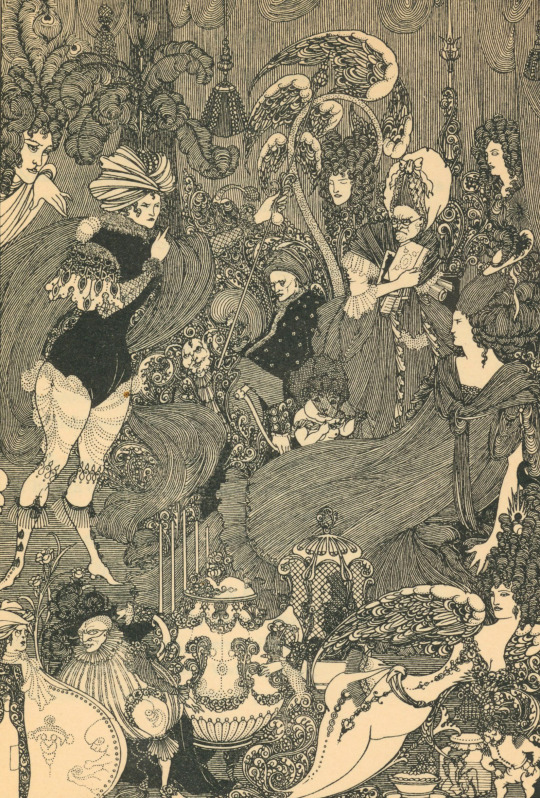
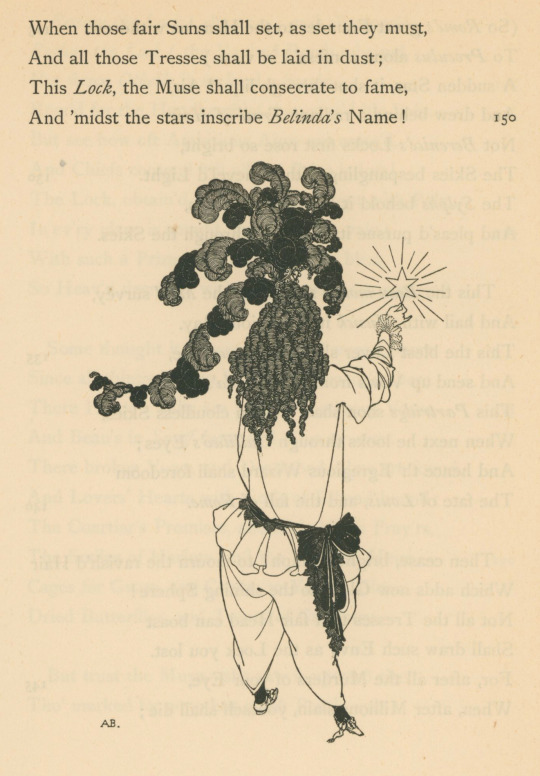
It’s Fine Press Friyay!
This week we’re digging into our 1896 copy of Alexander Pope’s (1688-1744) The Rape of the Lock: an heroi-comical poem in five cantos, which features decadent illustrations by Aubrey Beardsley (1872–1898). This crown quarto edition of 500 was issued in London by Leonard Smithers (1861-1907). It was printed on deckle edge paper at the Chiswick Press.
This publication is an excellent example of high burlesque, a style of satire in which “a literary, elevated manner was applied to a commonplace or comically inappropriate subject matter.” Pope’s epic treatment of a minor event of social trespass- the theft of a lock of Arabella Fermor’s (1696-1737) hair by Lord Petre (1689-1713), her suitor at the time of the incident and soon-to-be ex-fiancée, mocked the excessive role of social mores and morality in European culture of the era through exaggerated imitation.
Leonard Smithers was a London bookseller and publisher associated with the Decadent Movement, a 19th century Western European artistic and literary movement that prized aesthetic excess, artificiality, and hedonism. In addition to his support for Beardsley’s work, he also promoted the work of a number of controversial figure or the time including, amongst others, Max Beerbohm, Aleister Crowley, and Oscar Wilde.
The Chiswick Press was founded in 1811 by Charles Whittingham (1767–1840), who found success in producing accessibly priced editions of classics. His nephew Charles Whittingham II (1795–1876), who took over in 1840, was known for printing William Morris’s (1834-1896) early work, and would establish the press as part of the Private Press Movement in England, which started in reaction to the mechanization of book production. Contributors to the Private Press Movement championed the material qualities of their publications, lending heightened consideration to aesthetic choices and reviving traditional techniques of typography, binding, paper making, and printing.
--Ana, Special Collections Graduate Intern
View more Chiswick Press posts
View more Alexander Pope posts
View more Aubrey Beardsley posts
view more Fine Press Friday posts.
#Fine Press Friday#Fine Press Fridays#Chiswick Press#Aubrey Beardsley#Alexander Pope#crown quarto#The Rape of the Lock#high burlesque#satire#Decadent Movement#Leonard Smithers#Private Press Movement#Arabella Fermor#Lord Petre#Ana
72 notes
·
View notes
Text





A Goose Family Feathursday
Mildred and Horace Start a Family!!
Every spring for the past few years a mating pair of Canada Geese take up residence on the green roof outside our window for a couple of weeks. We've named them Horace and Mildred, and we did a post about them in 2021. We wondered if they would ever establish a nest in the roof's sedum, but they just hang out for a few weeks and then depart. This year they finally decided that our roof was suitable to start a family and about 20 days ago Mildred set up housekeeping with a downy nest and six eggs near one of the vents on the roof. We are all very excited here in Special Collections, and we maintain daily goose alerts!
Mildred will incubate her brood for about 30 days, rarely leaving the nest. She is a very devoted mother. Horace on the other hand is usually gone during the day, so we rarely see him. Canada Geese are monogamous and mate for life, so we don't think he's cheating on Mildred, but we all thought he would be more present as the male usually hangs about to help guard the nest, but apparently he has other ideas.
We should see some hatchlings in about ten days or so, and we'll bring you an update then. While we are interested in seeing the couple nest on our roof, we also have concerns. There is no water, and the goslings will be susceptible to falling off the roof and becoming prey to raptors and other avian predators, especially the peregrine falcons that raise their own families on the nearby roofs of our campus's tallest buildings. Nature will have its way, but we do hope that Mildred and Horace have strategies for keeping their family safe.
Stay tuned!
View more Feathursday posts.
257 notes
·
View notes
Text

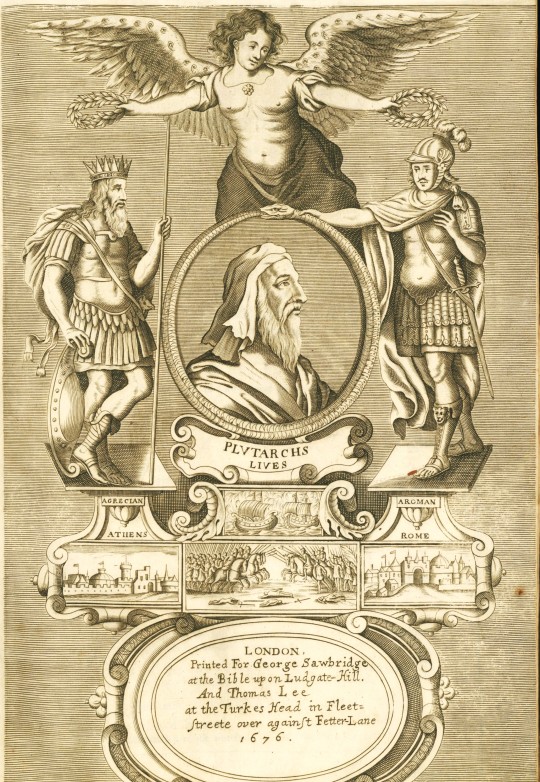

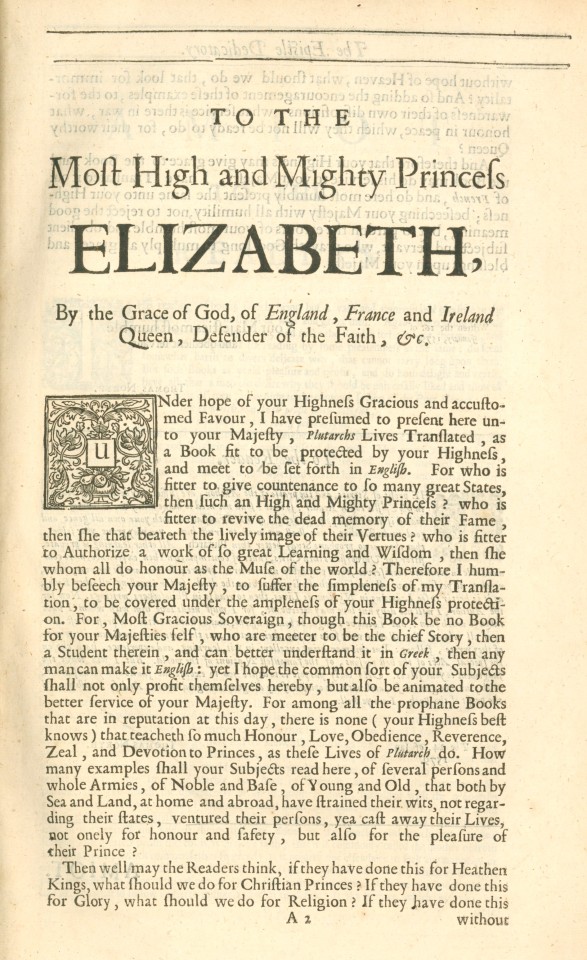



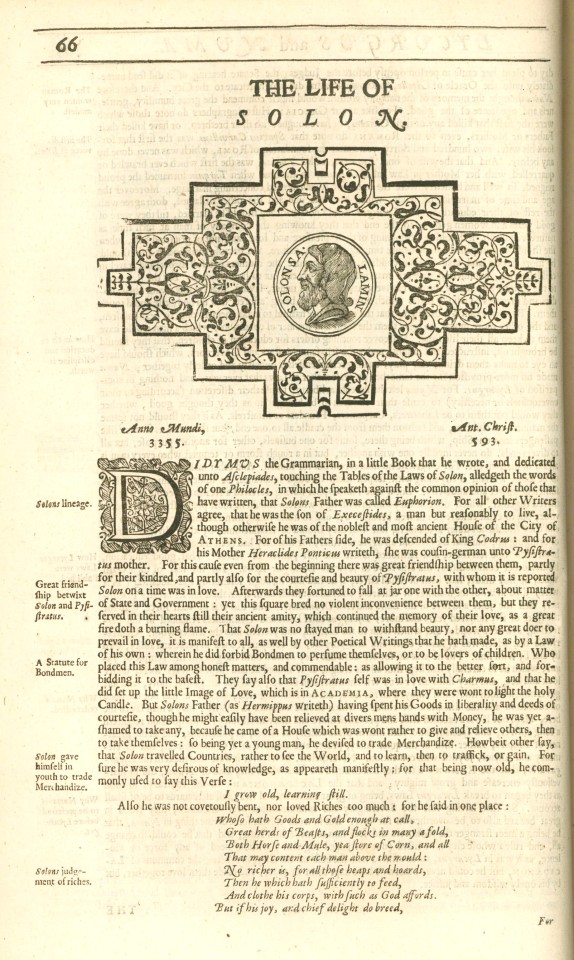

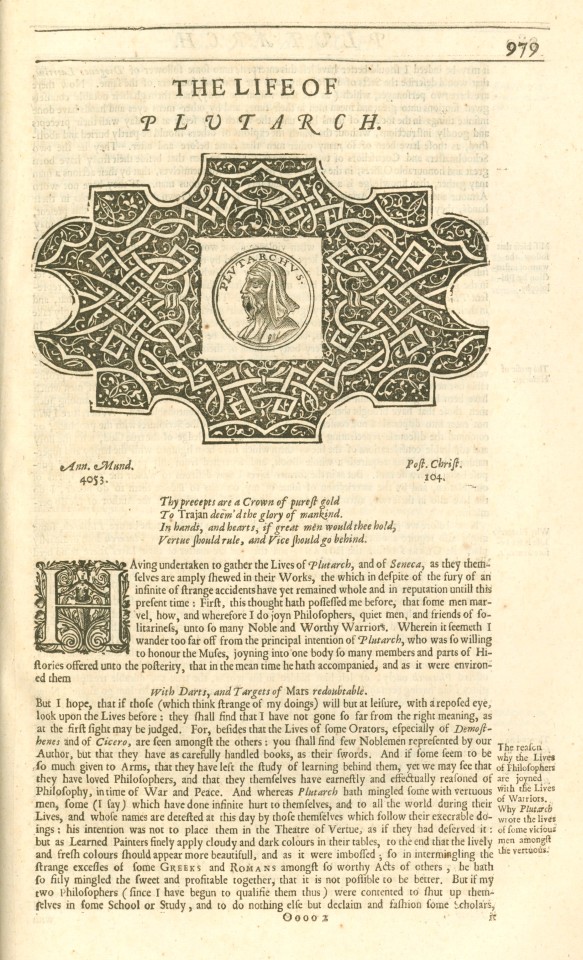
Classic Profiles
This is a 1676 edition of The Lives of the Noble Grecians and Romans, compared together by the 1st-century BCE Greek philosopher and historian Plutarch of Chaeronea, printed by the printer to the University of Cambridge John Hayes for the bookseller George Sawbridge. Originally written in Greek, Plutarch's Lives appeared in print for the first time as a Latin translation in 1470, and this English translation by Sir Thomas North was first published in 1579 from a French translation by James Amiot (Jacques Amyot). The text is a collection biographies of famous Greeks and Romans, including Alexander the Great, Pericles, Tiberius Gracchus, and Cicero. These figures left an indelible mark on history, their lives and achievements shaping the world as we know it.
Sir Thomas North (1535 – c. 1604) was an English translator and lawyer significantly contributing to English literature. His translation of Plutarch's Lives served as the primary source text for William Shakespeare's Roman plays, a testament to his work's enduring influence. This translation is regarded as one of the earliest examples of exceptional English prose. It was followed by another edition in 1595, which included updated biographies. A third edition of North's Plutarch was published in 1603, including even more translated Parallel Lives and a supplement of other biographies.
Jacques Amyot (1513-1593), a French scholar, writer, and translator, made substantial contributions to the field of translation and literature. His work on the translation of Plutarch's Lives (1559-1565) was instrumental in shaping the literary landscape of his time and laid the foundation for future translations and interpretations of Plutarch's work.
The first edition of this book was dedicated to Queen Elizabeth I. This dedication reflects the book's significance and provides a glimpse into the political and cultural landscape of the time, adding another layer of depth to the reader's understanding. Plutarch’s Lives helped shape the understanding of the classical Greek democracies and oligarchies of the Roman Republic and the role attributed to their founders—among them the legendary Lycurgus of Sparta and the Athenian lawgiver Solon.
-Melissa, Special Collections Classics Intern
View other Classics posts
#classics#greek posts#greece#roman#cambridge#plutarch#ancient greece#roman republic#alexander the great#lycurgus#solon#queen elizabeth i of england#biography#sappho#constantine the great#pericles#Thomas North#James Amiot#Jacques Amyot#John Hayes#university of cambridge
110 notes
·
View notes
Text
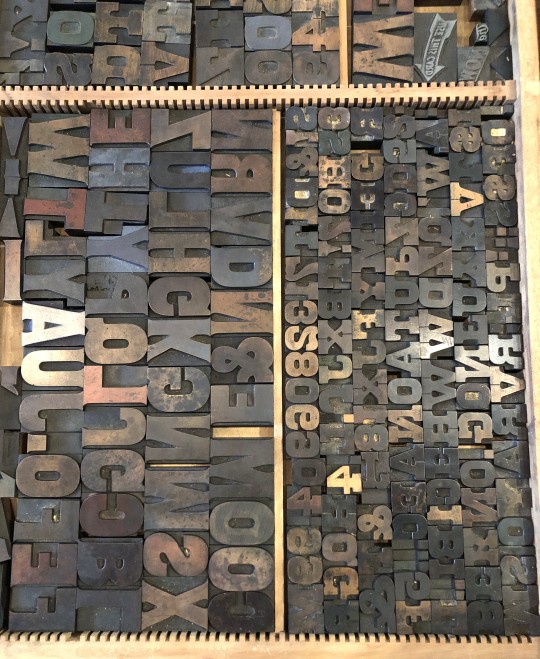



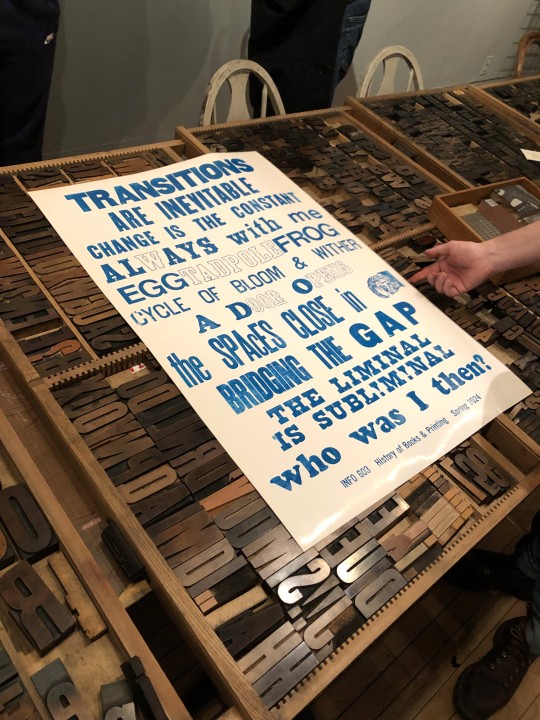

Typography Tuesday
PRINTING WITH WOOD TYPE!
Every semester, when we finally get to the invention of letterpress printing in Europe in my History of Books & Printing course, we all head over to a local print shop to set type and print a collaborative broadside. Last week we did just that and went over to Adam Beadel's Team Nerd Letterpress in the Walker's Point neighborhood of Milwaukee.
Usually, we compose in metal type, as that is what the students just learned about, but Adam recently received a huge influx of foundry type that wasn't set up yet, so we had to use wood type instead. Even though we wouldn't learn about the invention of production wood type for a few weeks, we were game because wood type is the best!
Each student was assigned to come up with a 3-5-word phrase based on the theme of "Transitions." They set their own phrase in wood type, I arranged the phrases into an exquisite corpse poem, we locked up the type on the bed of a poster press, and pulled a proof in blue ink (second to last image). Everyone was satisfied with the results, and with only a couple of adjustments, the students went on a tear, inking up the type in a rainbow of colors (last image), and pulling 15 more prints. Everyone went home exhausted and happy.
There are few things more thrilling than making your own letterpress prints. Thanks Adam!!!
View another letterpress post from a previous book history session.
View other posts on wood type.
View our other Typography Tuesday posts.
-- MAX, Head, Special Collections
#Typography Tuesday#typetuesday#instructions sessions#students#graduate students#Information Studies#INFOST 603#History of Books & Printing#letterpress#letterpress printing#wood type#Adam Beadel#Team Nerd Letterpress#type setting#broadsides#student work#exquisite corpse
111 notes
·
View notes
Text
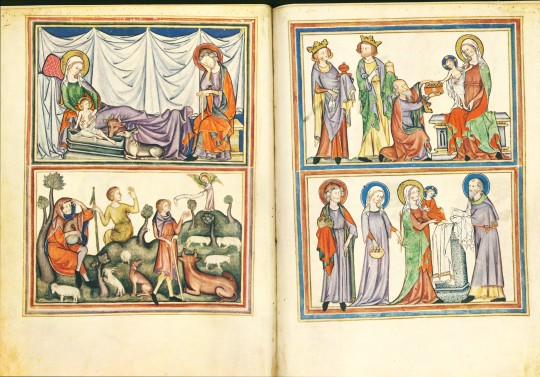
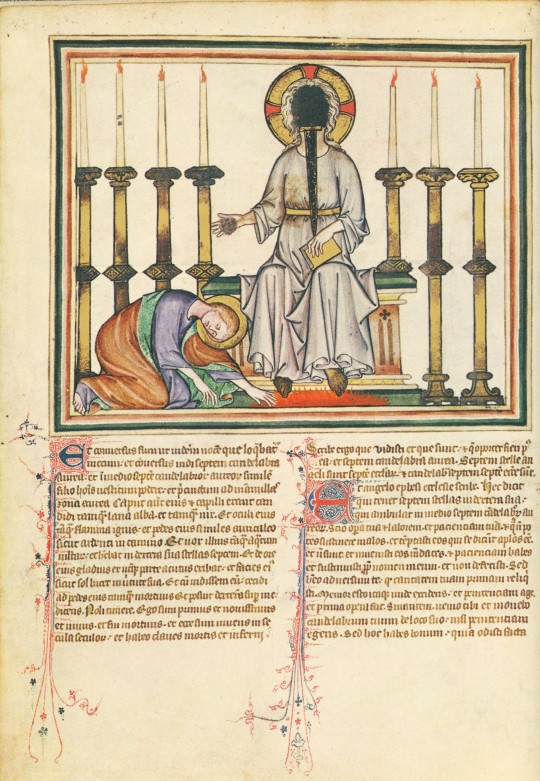



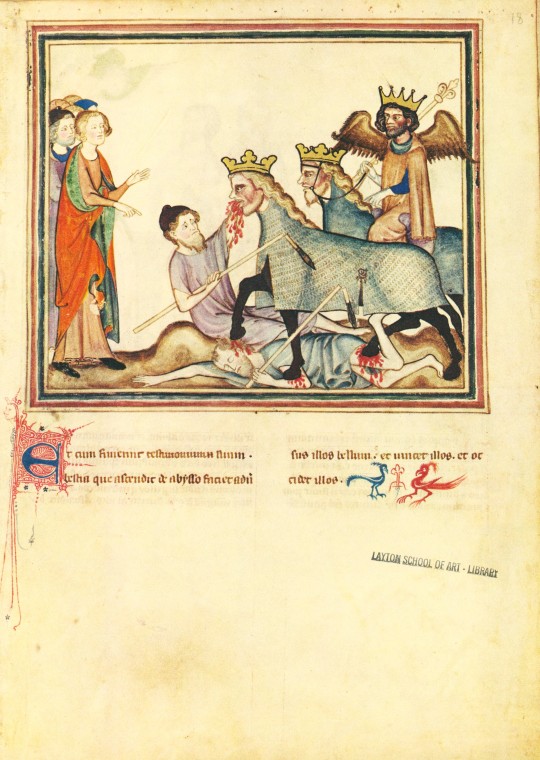
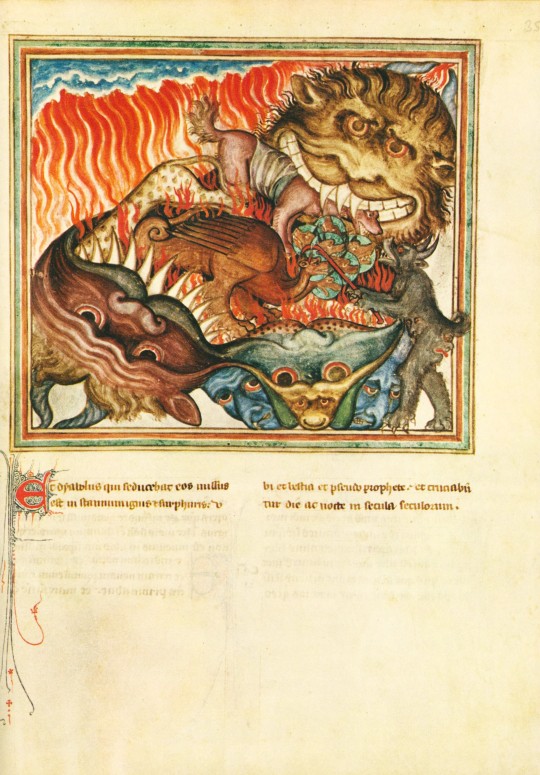

An Apocalyptic Manuscript Monday
This week we present our facsimile of the 14th-century Cloisters Apocalypse, published in 1971 by the Metropolitan Museum of Art in New York. As described in the introduction to the commentary about the manuscript, “[famine], pestilence, strife, and untimely death inspired apocalyptic fantasies and movements in Europe throughout the Middle Ages” (page 9), and this environmental influence led to the popularity of apocalyptic manuscripts like this French Apocalypse. Made in the 1330s for a Norman aristocratic couple, this manuscript has a few interesting details that set it apart from other Apocalypses, especially in relation to two other manuscripts in London (British Library, Add. Ms. 17333) and Paris (Bibliothèque Nationale, ms. Lat. 14410) that share similar formats, styles, and sequences with the Cloisters manuscript.
The first unique detail is the prefatory cycle of the life of Jesus in the introductory folios (1-2 verso). Since the Apocalypse of St. John the Divine (also known as the book of Revelation) was written by a titular St. John, prefatory cycles in Apocalypses usually consist of his life, rather than Christ’s. The other aspect of this manuscript that makes it distinct amongst its sister manuscripts is the addition of a dedication page on folio 38 verso. This page shows a man and woman kneeling in front of a tonsured saint and the Virgin and Child, respectively, representing the people for whom this manuscript was originally made for.

Interestingly, this manuscript also has multiple pages added to the original manuscript. Pasted on the inside front cover are handwritten provenance notes. The manuscript also did not originally include chapters and verses 16:14 through 20:3, and pages with this text were later added to the manuscript after the dedication page.
The materials used to create this manuscript include tempera, gold, silver, and ink on parchment with a later leather binding. If you are interested in seeing this unique Apocalypse manuscript, you can either use our facsimile, visit Gallery 13 of the Metropolitan Museum of Art’s Cloisters where the original is on display, or view their digital presentation of the manuscript.
View other posts on our facsimiles of illuminated manuscripts.
– Sarah S., Special Collections Graduate Intern
#manuscript monday#apocalypse#cloisters apocalypse#the cloisters#met#the metropolitan museum of art#manuscripts#illuminated manuscripts#french manuscripts#book of revelation#Revelation of St. John#facsimiles#manuscript facsimiles#Sarah S.
50 notes
·
View notes
Text










Milestone Monday
April 15th is National American Sign Language (ASL) Day, observed annually to celebrate the ASL community and its contributions to inclusivity, and to encourage folks to learn the language. Regarded as a natural language, sign language has likely existed for as long as there has been a need to communicate, however, the emergence of ASL is largely credited to Thomas Gallaudet (1787-1851) founder of the American School for the Deaf. Uniting deaf children from the western hemisphere the American School for the Deaf was fertile soil for language contact, developing ASL from French Sign Language, village sign languages, and home sign systems. Today, more than a half-million people throughout the United States use ASL to communicate as their native language.
In recognition of the day, we’re sharing another book from our Historical Curriculum Collection the Basic Pre-School Signed English Dictionary published by Gallaudet College Press in 1973. Signed English features drawn signs with written instructions to represent 975 words most frequently used by and with pre-school children. The editors also include sign markers and the American Manual Alphabet to be used in conjunction with the vocabulary, encouraging a language that is adaptable and offers a more complete English model of communication.
Signed English was edited in part by Harry Bornstein and Karen Saulnier who worked on several signing books for young readers throughout the 70s, 80s, and 90s, and illustrated by Jack Fennell and Ann Silver.
Read other Milestone Monday posts here!
– Jenna, Special Collections Graduate Intern
#milestone monday#national american sign language day#asl#thomas gallaudet#american school for the deaf#basic pre-school signed english dictionary#Gallaudet College Press#Harry Bornstein#Karen Saulnier#Jack Fennell#Ann Silver#historical curriculum collection#children's books
83 notes
·
View notes
Text


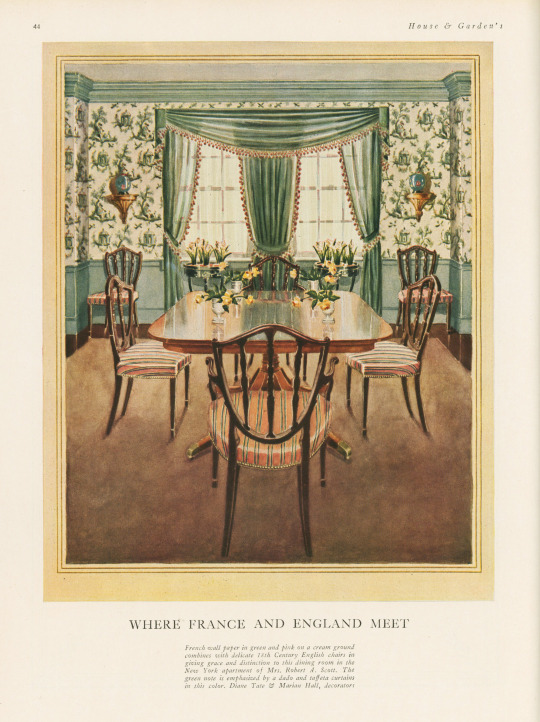


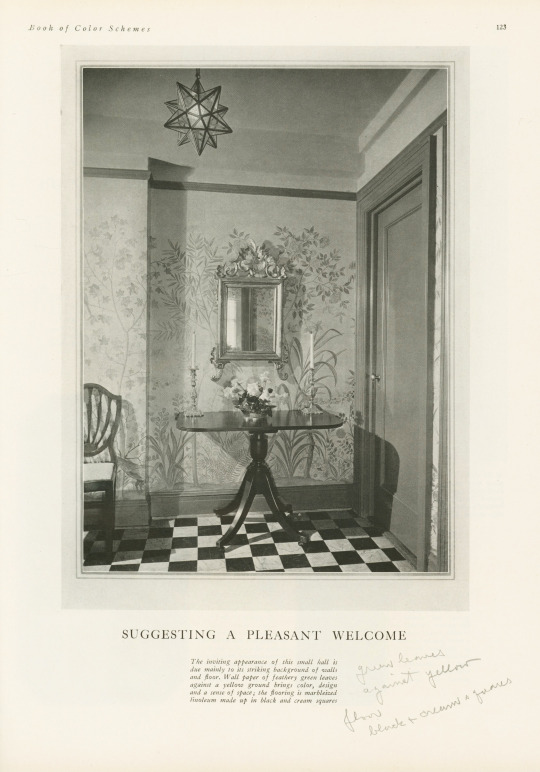



Decorative Plates
It's been awhile since we last posted something on the theme of the decorative arts, so I'm happy to have found this book—especially because it was mis-shelved in the stacks! This book is House and Garden's Book of Color Schemes, which contains "over two hundred color schemes and three hundred illustrations of halls, living rooms, dining rooms, bed chambers, sun rooms, roofs, garden rooms, kitchens and baths; the characteristic colors of each decorative period; how to select a color scheme, with unusual treatments for painted furniture and floors; a portfolio of crystal rooms and eight pages of unusual interiors in color." It was edited by long-time editor of House & Garden Richardson Wright (1887-1961) and Margaret McElroy, associate editor, and published by Condé Nast Publications, Inc. in 1929.
The book includes a large number of photographs of rooms, however, they are mostly in black and white—an unfortunate thing for a book about color! The promised eight color illustrations of rooms are not all present in our copy, but the five that are still in the book are shown here, alongside some of their black and white compatriots. I especially love the one titled "Tawny Yellow in Variety" that features a shocking amount of leopard print.
If you've read any of the posts I usually write, you know that I love a good binding—this one is a publisher's binding in a chartreuse-y yellow book cloth with art deco-style silver tooling featuring stars and leaves. Somebody took it upon themselves to write the publication date on the cover above the title—how thoughtful!
View more posts featuring Decorative Plates.
-- Alice, Special Collections Department Manager
#Decorative Sunday#Decorative Plates#decorative arts#House and Garden's Book of Color Schemes#color schemes#color#decoration#home decor#interior decorating#Richardson Wright#Margaret McElroy#Conde Nast#Conde Nast Publications#art deco#chartreuse#Publishers' bindings
73 notes
·
View notes
Text




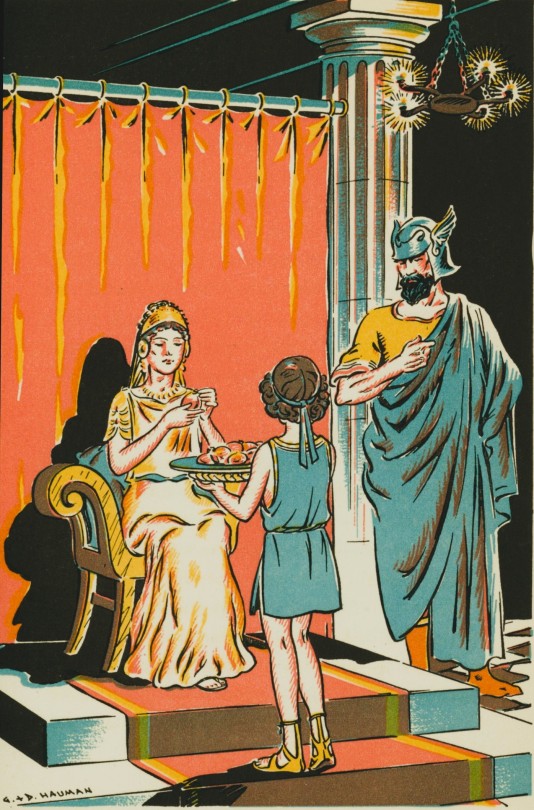


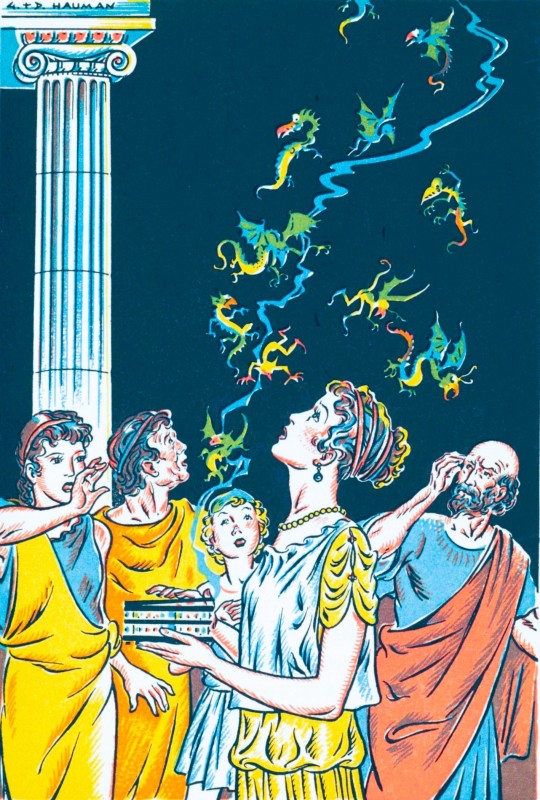



Greek Child's Play
Published in 1945 by Little Brown & Company, Adventures with the Gods by Catharine Sellew and illustrated by George and Doris Hauman is a charming primer created for young children. It contains sixteen stories featuring the heroes of Greek mythology as well as the gods and goddesses of Mount Olympus. The book even includes a handy index of all the characters' names and how to pronounce them. This delightful collection of stories provides an accessible introduction to the fascinating world of Greek mythology, making it an enchanting read for both children and adults.
Catharine Sellew, an American author, has a talent for turning ancient myths and legends into children's stories. Written using simple language and ideas, her stories create an almost fairytale-like experience for readers. It's no surprise that her works are captivating and beloved by many.
George and Doris Hauman were a married couple and American children’s book illustrators. They are perhaps most well-known for illustrating the popular 1954 edition of The Little Engine That Could. The couple decided to collaborate on projects because they had so many customers in common. They also used a joint signature for all of their illustrations.
View other Classics posts.
View our other posts on children's books.
-Melissa, Special Collections Classics Intern
#Classics#greek mythology#greek gods#Adventures with the Gods#Catharine Sellew#George and Doris Hauman#Little Brown & Company#little brown books for young readers#goddesses#illustrations#myths#mythology#children's books#Historical Curriculum Collection
146 notes
·
View notes